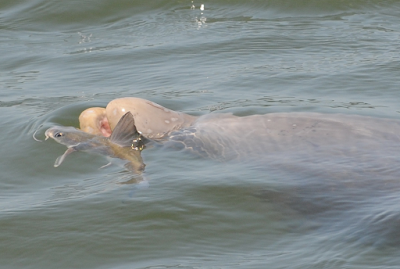Abstract
Few accounts describe predator-prey interactions between common bottlenose dolphins (Tursiops truncatus Montagu 1821) and marine catfish (Ariopsis felis Linnaeus 1766, Bagre marinus Mitchill 1815). Over the course of 50,167 sightings of bottlenose dolphin groups in Mississippi Sound and along the Florida coast of the Gulf of Mexico, severed catfish heads were found floating and exhibiting movements at the surface in close proximity to 13 dolphin groups that demonstrated feeding behavior. These observations prompted a multi-disciplinary approach to study the predator-prey relationship between bottlenose dolphins and marine catfish. A review was conducted of bottlenose dolphin visual survey data and dorsal fin photographs from sightings where severed catfish heads were observed. Recovered severed catfish heads were preserved and studied, whole marine catfish were collected and examined, and stranding network pathology reports were reviewed for references to injuries related to fish spines. Photographic identification analysis confirms eight dolphins associated with severed catfish heads were present in three such sightings across an approximately 350 km expanse of coast between the Mississippi Sound and Saint Joseph Bay, FL. An examination of the severed catfish heads indicated interaction with dolphins, and fresh-caught whole hardhead catfish (A. felis) were examined to estimate the presumed total length of the catfish before decapitation. Thirty-eight instances of significant trauma or death in dolphins attributed to ingesting whole marine catfish were documented in stranding records collected from the southeastern United States of America. Bottlenose dolphins typically adhere to a ram-feeding strategy for prey capture followed by whole prey ingestion; however, marine catfish skull morphology may pose a consumption hazard due to rigid spines that can puncture and migrate through soft tissue, prompting a prey handling technique for certain dolphins, facilitating consumption of the posterior portion of the fish without the head.
 |
| Fig 1. Severed catfish head (Bagre marinus) found near dolphins demonstrating foraging behavior near Palma Sola Bay, FL (SAR). |
 |
| Fig 3. Bottlenose dolphin interacts with a hardhead catfish (Ariopsis felis) near Palma Sola Bay, FL (SAR). The dorsal and pectoral spines of the fish appear locked in their defensive positions. |
Conclusion:
Bottlenose dolphin feeding morphology has evolved towards a ram-feeding mode without significant oral processing of prey; however, these observations of SCH suggest dolphins in the nGoMx have developed a prey handling technique to reduce potential complications from the venomous and sharp spines of marine catfish. The present study indicates some dolphins are targeting marine catfish when other prey is likely available, despite the additional energy presumably expended to decapitate each fish. Marine catfish in spawning aggregations may offer bottlenose dolphins a prey source with a positive energy trade-off due to their egg production and propensity for sonic activity. Generally, bottlenose dolphin diet studies find a relatively low occurrence of marine catfish, however, those data may reflect a lack of ingested otoliths due to successful decapitations or a bias towards a diet less representative of dolphins with extended movement patterns extralimital to the study population. The dorsal fin matches in dolphin groups associated with this rarely observed prey handling technique across these survey areas may indicate a need for specific studies (e.g., focal follows, remote tissue biopsy) to determine the extent to which this prey handling technique is related to factors such as ecology, genetics, or social transmission.
Errol I. Ronje, Kevin P. Barry, Carrie Sinclair, Mark A. Grace, Nélio Barros, Jason Allen, Brian Balmer, Anna Panike, Christina Toms, Keith D. Mullin and Randall S. Wells. 2017. A Common Bottlenose Dolphin (Tursiops truncatus) Prey Handling Technique for Marine Catfish (Ariidae) in the northern Gulf of Mexico. PLoS ONE. 12(7); e0181179. DOI: 10.1371/journal.pone.0181179
In the Gulf of Mexico, dolphins have learned a deadly new trick.
hakaimagazine.com/news/dolphins-master-decapitation/ via @hakaimagazine


